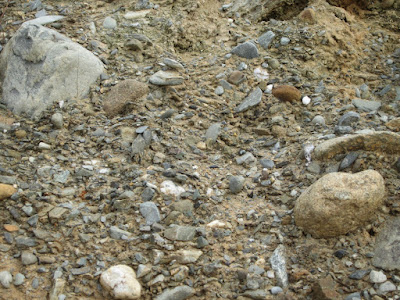In 1962-65 I took scores of samples from across North Pembrokeshire Quaternary exposures (mostly on the coast) and spent many weeks in the laboratory laboriously sieving and recording percentages. These are just some of the results.
These graphs show cumulative percentages on the left and particle sizes on the bottom. Click to enlarge. This top graph, for samples of calcareous Irish Sea Till such as that in the photo, shows a set of deposits that are well sorted, with very little material larger than .5 mm diameter and between 30% and 40% silt and clay. This is typical sea floor material, dredged up and incorporated into glacial deposits. There are some clasts included, of course, but for the purpose of matrix examination these were rejected. In the real world, of course, this sort of analysis is useful to a degree in diagnosis, but you use many other factors as well in deciding what you are looking at -- colour, striated clasts, stone orientation, microfabric, provenance of erratics, fossil types, reaction with dilute HCl and so forth. This till is exposed mostly on the north coast of Pembrokeshire and around Druidston on St Bride's Bay, where the ice has come directly onshore after passing across old sea floor deposits. This type of till is often referred to as a "lodgement till" because of the manner in which it is effectively plastered onto the bed under high pressure.
This second graph is for other samples of till including what I call the "land facies" of the Irish Sea Till, deposited from glacier ice that has passed across the inland landscape, picking up local broken rock materials and pre-existing sediments including -- of course -- a great deal of material from old slope deposits and valley fills. Here there are larger proportions of coarse and very coarse sands -- in fact in many samples I had to exclude not just larger clasts but also gravels as well, with particles larger than 2 mm in diameter. Some sample have quite high silt and clay contents, but the curves on the graph are not so sharply concave, indicating a much lower degree of sorting than in the Irish Sea Till proper. The till at Rhosyfelin is in this category, and from examinations of the textures across the site it is quite variable -- sometimes clay-rich, and in other places sandy and gravelly. Again that is typical of a depositional environment where till is melting out and sometimes flowing. The photo above, by the way, is of meltout or ablation till at Aber Mawr.






No comments:
Post a Comment